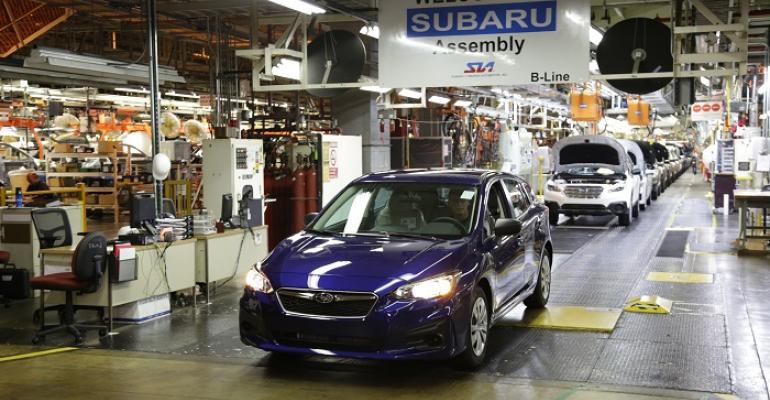LA JOLLA, CA – The fifth-generation Impreza now launching in the U.S. marks the debut of Subaru’s new global platform, which in the next five to six years will underpin all the brand’s models.
It’s a platform Subaru sees as an agent of change, designed to bring it even more buyers and hopefully helping extend its 60-month streak of U.S. sales gains.
Since 2007, Subaru volume has tripled in the U.S., going from roughly 200,000 annually to nearly 600,000 through November.
“This is probably the most exciting news with the whole car,” Todd Hill, Impreza car line manager-Subaru of America, tells media here at a ’17 Impreza preview. “It’s designed for all future models (and powertrains/propulsion systems) going forward. It’s going to give us greater development efficiency and production efficiency, because there’ll be more shared parts and components and common assembly processes.”
This leaves more time and money to differentiate areas customers notice most, he adds.
Depending on the model, Subaru buyer’s No.1 or No.2 purchase reason in the U.S. is safety, and Hill says this is where the new platform should have the biggest impact.
“It’s just such an increase in the safety performance for our brand,” he says. “The collision-energy absorption is 40% higher than today. This is just an enormous step. The center of gravity height is 0.2 in. (5 mm) lower. That’s going to help hazard avoidance so you can prevent being in an accident.”
Hill says the platform should meet current and future safety requirements and regulations, at least through 2025, and doesn’t increase weight thanks to use of more advanced high-strength steels.
The Impreza has 9%-10% of 1470 MPa-grade steel (variable between the sedan and hatch body styles), up from 1% in the outgoing fourth generation of the compact car. Steel of 440 MPa grade now accounts for 57% of the Impreza body, up from 45%.
Hill promises the new Impreza overall is stiffer, tighter and exhibits less shake due to beefier and stiffer joints and attachment plates. The ’17 model uses structural adhesive, a first for Subaru. Some 23 ft. (7 m) of adhesive is used throughout the car, helping load transmission in a collision but also reducing noise, vibration and harshness.
The front bulkhead, where the side rails, shock towers, windshield and firewall unite, “is so beefy, so strong (and) makes a big difference in terms of crash safety,” Hill says.
The Impreza’s B-pillar uses tailor-welded blanks, also a Subaru first. The B-pillar is thicker at the bottom attachment point for impact strength, but thinner at the top for improved center-of-gravity height.
The layout of frame rails and frame components also is revised on the Impreza platform, with the front frame up 20% in impact resistance from the fourth-gen model.
Aiming for 800,000
Subaru wants to best the Impreza’s prior sales recordof 81,799, set in 2012, possibly hitting 90,000-100,000 annual deliveries with the new model. The ʼ17 also features a revised 4-cyl. engine and added advanced safety technology, including a reverse emergency-braking function, and more infotainment features, such as TomTom navigation and a bird-watching app.
Subaru projects U.S. sales to surpass the 600,000 mark sometime mid month, pulling the automaker’s 2016 goal ahead a bit, says a company spokesman. Subaru sales through November tallied 551,955, up 4.9% from like-2015, WardsAuto data shows.
Subaru has its sights set on 670,000 U.S. sales in 2017 and 800,000 by 2020.
Helping it get there will be new capacity at its sole U.S. plant in Lafayette, IN. The facility now can build just shy of 400,000 units annually, although this year will finish with about 300,000. Its previous straight-time capacity was 200,000 units annually.
With the ’17 Impreza, Lafayette becomes the sole source of the compact sedan and hatch for the U.S. It also will build the car for Canadian and Mexican markets.
The new capacity also will boost availability of the Legacy midsize sedan and Outback midsize CUV, up 8.5% and 19.1%, respectively, through November. The Outback is Subaru’s No.1-selling model in the U.S., with 162,203 deliveries this year.
With the new capacity, Lafayette is physically maxed out, but can increase line speed and use overtime to go beyond 400,000.
Subaru in 2018 will launch a new 7-seat large CUV based on the Viziv concept shown at last month’s Los Angeles auto show. The CUV will be built at the Indiana plant, but the spokesman says it is unclear if Lafayette’s 400,000-unit capacity will be enough to accommodate demand.
Impreza production began early last month with an initial 70/30 mix of hatches and sedans, although Subaru aims to get the car’s take rate closer to 50/50 between the two body styles.
Lafayette’s labor force numbers 5,000 and Buddy Penquite Jr., assistant senior manager-production control at the Lafayette plant, says it has been difficult to find qualified workers in a relatively small town.
“It’s a bit of a struggle,” he says. “We did go a little bit further out” in search of applicants, noting the automaker went to Fort Knox, KY, and recruited ex-Army members. Fort Knox is 212 miles (341 km) from Lafayette.





